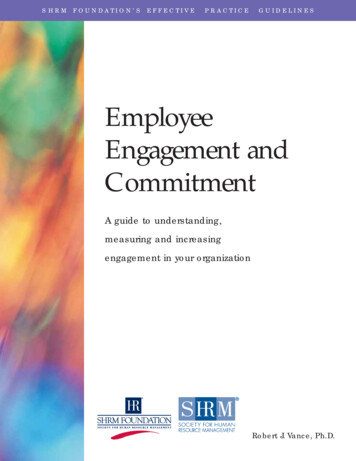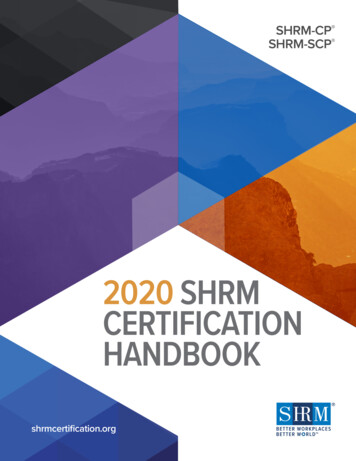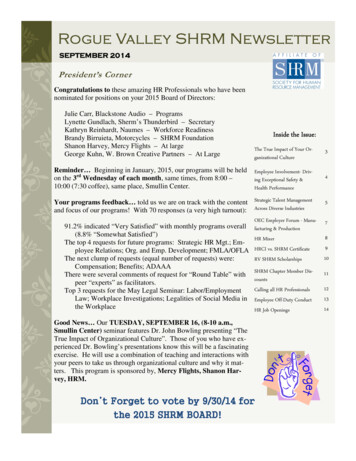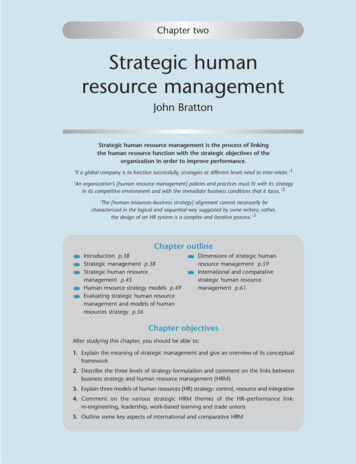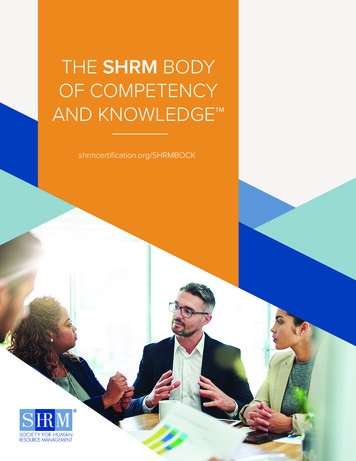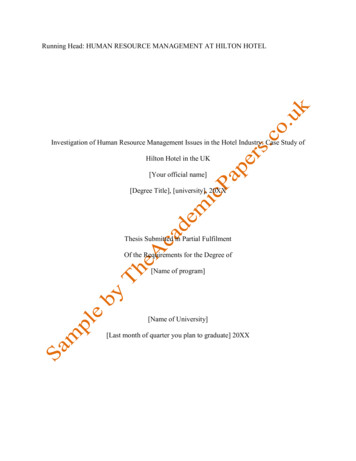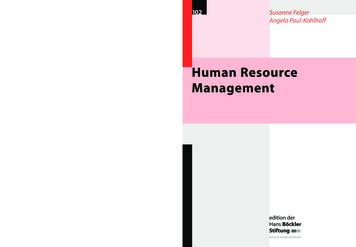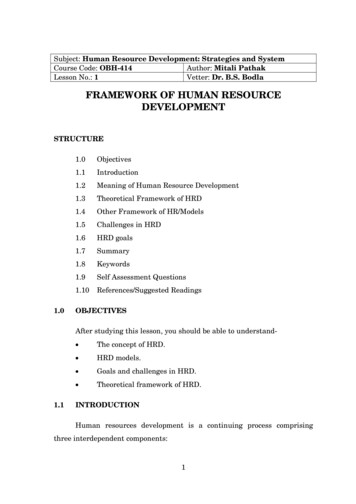
Transcription
SHRM HUMANRESOURCECURRICULUMGuidebook and Templatesfor Undergraduate andGraduate Programs
PROJECT TEAMInternal contributors: Nancy R. Lockwood, M.A., SHRM-SCPNancy A. Woolever, MAIS, SHRM-SCPAlexander Alonso, Ph.D., SHRM-SCPJoseph A. Jones, Ph.D., SHRM-SCPLindsay Northon, MA, SHRM-SCPExternal contributors:American Institutes for Research Copy editor:Katya ScanlanGraphic designer:Anca PopaDisclaimer: This guidebook is published by the Society for Human Resource Management (SHRM). Allcontent is for informational purposes only and is not to be construed as a guaranteed outcome. TheSociety for Human Resource Management cannot accept responsibility for any errors or omissions orany liability resulting from the use or misuse of any such information. 2018 Society for Human Resource Management. All rights reserved.17-0920
ForewordDriven by powerful changes in the business environment, organizations of all types—from start-ups tomultinationals, not-for-profit to governmental, local to global—are demanding strategic leadership from humanresource (HR) professionals. Today, the breadth and depth of business knowledge, as well as the mastery ofmanagement skills required of HR professionals, are unprecedented.The Association to Advance Collegiate Schools of Business (AACSB International) and the Society for HumanResource Management (SHRM) believe that the human resource student is best prepared for a career in HRwhen HR is taught within the business context.AACSB takes its role in aligning management education with the interests of society seriously, and thereforeSHRM’s initiative to strengthen HR degree programs is of enormous interest to AACSB, with its network ofmore than 1,500 business schools worldwide dedicated to advancing quality management education.The guidebook and associated templates developed by SHRM are the result of a highly interactive, ongoingprocess involving practitioner and academic communities. These guidelines are flexible and focused onoutcomes, with the goal to assist educators to realign curricula and courses, publicize their programs andmeasure results. The goal of this guidebook is to strengthen business and HR education worldwide. AACSBcommends SHRM for its leadership in guiding HR education and encourages business schools to use theguidebook and templates to develop and reformulate their HR degree programs.Daniel R. LeClair, Ph.D.Executive Vice President and Chief Strategy and Innovation OfficerAACSB InternationalSHRM HUMAN RESOURCE CURRICULUM GUIDEBOOK AND TEMPLATES FOR UNDERGRADUATE AND GRADUATE PROGRAMS1
TABLE OF CONTENTSIntroduction . 3Elevating the Quality of Education in Human Resource Management. 32018 HR Content Areas at a Glance. 4SHRM Research on HR Education. 5Development of the SHRM HR Curriculum Guidelines. 5State of HR Education (SOHRE) Longitudinal Study. 6SHRM Revalidation of the HR Curriculum Guidelines.7Participation in Internships: Why Internships Are Important.7Development of the SHRM HR Curriculum Guidebook and Templates. 9SHRM Competency Model.11SHRM Certification Exams. 12HR Curriculum 2018: The Changing Nature of HR Education. 13Overarching Tenets of the SHRM Curriculum Guidelines.15Important Elements of HR Curriculum.15Key Results of the 2017 SHRM Curriculum Guidebook Revalidation Study. 18SHRM Competencies.18Required HR Content Areas.18Secondary HR Content Areas.18Value Ratings of HR and Business Content Areas by Academicians and HR Professionals.19Curriculum Templates: Sample Course Outlines for Creatingor Modifying an HR Degree Program. 21 Undergraduate Curriculum:A Sample Template for Structuring a Bachelor of Business Administration (BBA)or Bachelor of Science in Business Administration (BSBA) with a Concentration in HRM.22 Graduate Curriculum:A Sample Template for Structuring a Master of Business Administration (MBA)Curriculum with a Concentration in HRM.26 Graduate Curriculum:A Sample Template for Structuring a Master of Scienceor Master of Arts in Human Resource Management (Within a Business School).29Analyzing Your University’s HR Degree Program for Alignment. 33Appendix A: Required and Secondary HR Content Areas, and the SHRM Competencies. 34Appendix B: Additional Skill Development and Competency Lists. 42Appendix C: Useful SHRM Links. 44Appendix D: Acknowledgments. 45References. 462SHRM HUMAN RESOURCE CURRICULUM GUIDEBOOK AND TEMPLATES FOR UNDERGRADUATE AND GRADUATE PROGRAMS
INTRODUCTIONINTRODUCTIONELEVATING THE QUALITY OF EDUCATION IN HUMAN RESOURCE MANAGEMENTThe Society for Human Resource Management (SHRM) has long held an interest in attracting the bestand the brightest talent to the HR profession. The competitive nature of today’s global marketplace andthe increasingly strategic nature of the profession demand a higher level of readiness. To become an HRprofessional, one must be well prepared. A critical first step is earning a well-rounded, robust undergraduateor graduate degree in human resources.Many choices will be made throughout the career progression of an HR professional. To advance the level ofpreparedness necessary to enter the HR field, SHRM’s strategy regarding HR education focuses on a certainpath for students. Choosing to follow an HR career path requires a strong interest in—and dedication to—lifelong learning.Once the decision is made to pursue HR as a career, SHRM believes that a critical step is to receive a formaleducation in HR, including through HR internships and other HR-specific experiential learning activities. Afterearning a degree and securing employment in the HR field, gaining HR-related work experience leads tocareer progression. Throughout this process, a key goal is to earn professional HR credentials. The SHRMcertification exams offer an opportunity to gain certification and pursue continued learning through therecertification process. As the nature and content of the profession change and evolve, learning throughoutone’s career is essential (see Figure 1).Figure 1: How to Pursue a Career in Human Resources: Six Simple Steps to SuccessStep 1:Become a SHRMStudent Member& Grow YourNetwork.Step 2:Select HRas Your Major.Step 3:Gain Experience& CompetitiveAdvantage withHR Internships.Step 4:Graduate withYour Degree &Upgrade to aProfessional SHRMMembership.Step 5:Use the SHRMCompetencyModel to HelpYou Find ThatFirst HR Job.Step 6:Get Ready toAdvance YourCareer.SHRM HUMAN RESOURCE CURRICULUM GUIDEBOOK AND TEMPLATES FOR UNDERGRADUATE AND GRADUATE PROGRAMS3
INTRODUCTION2018 HR CONTENT AREAS AT A GLANCEAnchored in extensive research, this guidebook focuses on why it is important to define the parameters thatshould surround HR degree programs and sets out the framework for HR education. The majority of thisguidebook describes the history of SHRM’s academic initiative, the research that shaped it and the currentresearch on which the 2018 guidebook and templates are based. Table 1A summarizes the required andsecondary HR content areas to include in an HR degree program. To complement the SHRM CompetencyModel, the most current edition of the guidelines (2018) now includes the SHRM competencies as part ofthe requirement for the HR degree program to qualify for alignment with the SHRM HR curriculum guidelines(please see Tables 1A and 1B). Note that the 2018 guidelines reflect the results of the revalidation researchconducted in 2017 and will remain in effect until the research is revalidated again in approximately 2020.Table 1A: HR Content AreasRequired Content AreasSecondary Content AreasChange ManagementDownsizing/RightsizingCompensation and Benefits*Mergers and AcquisitionsEmployee and Labor RelationsOutsourcingEmployment LawSustainability/Corporate Social ResponsibilityGlobalizationHR Career PlanningHR’s Role in OrganizationsHuman Resource Information Systems (HRIS)Job Analysis and Job DesignManaging a Diverse WorkforceMetrics and Measurement of HROrganizational DevelopmentPerformance ManagementStaffing (Recruitment and Selection)Strategic HRTraining and DevelopmentWorkforce Planning and Talent ManagementWorkplace Health, Safety and Security*Exact language used during data collection was "Total Rewards (Compensation, Benefits)"Table 1B: SHRM CompetenciesRequired Competency AreasBusiness AcumenCommunicationConsultationCritical EvaluationEthical PracticeGlobal and Cultural EffectivenessLeadership and NavigationRelationship Management4SHRM HUMAN RESOURCE CURRICULUM GUIDEBOOK AND TEMPLATES FOR UNDERGRADUATE AND GRADUATE PROGRAMS
SHRM RESEARCH ON HR EDUCATIONSHRM RESEARCH ON HR EDUCATIONIn 2004 and 2005, SHRM undertook a series of studies designed to define parameters for universities to usewhen creating or modifying a degree program in human resources. The studies showed that organizations wantto know how to acquire, grow and retain HR professionals with a degree in HR. In addition, organizations seek HRprofessionals who know how to execute competitive and strategic human resource practices. Based on this work,in 2006, SHRM created the HR Curriculum Guidebook and Templates, focusing on how professional organizationsand academic programs educate students to prepare them for a career in HR.The role of HR professionals in organizations has transitioned from transactional, technical and administrative,to strategic for the development and accomplishment of organizational goals and objectives. Overall, due to thechanging nature of work—including knowledge-based industries and global competition for talent—human capitalis now viewed as a key asset in organizations. At the same time, there have been changes in the knowledge, skills,abilities (KSAs) and competencies required of HR professionals. Reflective of the changing nature and role of thehuman resource function, HR education must prepare future HR professionals with the essential competencies tomeet the demands of the HR field. As seen later in the guidebook (sections “Key Results of the 2017 CurriculumGuidelines Revalidation Study” and “Appendix A”), the eight SHRM competencies are now part of the requirementsfor an HR degree program to align with the curriculum guidelines.DEVELOPMENT OF THE SHRM HR CURRICULUMGUIDEBOOK AND TEMPLATESThe 2004 SHRM Symposium on the Future of HREducation, which brought together HR academicians,experienced practitioners and students, contributedto the development of the HR Curriculum Guidebookand Templates. A key finding was a strong consensusthat business and environmental changes would makethe HR role of the future more strategic, especially asthe nature of business becomes increasingly global.Symposium attendees pointed to a lack of clear andacceptable standards in HR education.The 2005 SHRM Symposium on the Future of StrategicHR also contributed to the development of theguidebook and templates. Senior-level HR practiceleaders, academicians and consultants concluded thatnot enough barriers were in place to prevent those whowere ill-prepared to practice HR from entering the field.Degree programs areincreasingly offering curriculumthat better prepares futureHR professionals to join theprofession at the entry level andmake meaningful and viablecontributions to an organization’ssuccess from day one.Since 2005, academic programs in HR have made greatstrides and responded to the needs in the employmentmarketplace. There is now a fairly common agreementon a defined set of HR content areas, knowledge andcompetencies that HR graduates should possess toenter the HR field. As more HR programs are offered incolleges and universities, SHRM’s experience workingwith universities shows that interest in human resourcesas a profession—and as a major area of study—hasgrown, with a greater agreement between academiciansand practitioners regarding what an education in HRshould cover. Degree programs increasingly offercurriculum that better prepares future HR professionalsto join the profession at the entry level and makemeaningful and viable contributions to an organization’ssuccess from day one.SHRM HUMAN RESOURCE CURRICULUM GUIDEBOOK AND TEMPLATES FOR UNDERGRADUATE AND GRADUATE PROGRAMS5
SHRM RESEARCH ON HR EDUCATIONOver the years, an emphasis on business knowledge of HR professionals has become more prominent.To solicit perceptions from academicians, students and practitioners of how well the curriculum preparedstudents for an HR career, in 2005 SHRM conducted quantitative studies of graduate and undergraduateHR curriculum. HR practitioners, many whom were in positions to hire new entrants to the HR field,overwhelmingly indicated the need for students to develop business knowledge outside of HR. HRpractitioners and academicians said that a degree in business with a concentration in HR was more valuablethan a degree in HR without the business emphasis. The results of current research support the emphasis onstudying HR within a business degree and show that a business-based HR degree is increasingly important.To ensure that new HR professionals enter the world of work equipped with adequate knowledge, skills andcompetencies to succeed in the workplace, SHRM and universities have an obligation to attract studentsto HR as a profession early in their career development. With an HR degree from a university that offers acomplete, robust and HR-specific educational curriculum—coupled with opportunities through internshipsand other HR-specific work experiences—students are better prepared to meet the expectations ofemployers and embark on the pathway that leads to life-long learning in the discipline.STATE OF HR EDUCATION (SOHRE) LONGITUDINAL STUDYFrom 2009 to 2013, SHRM collaborated with the American Institutes for Research (AIR) to conduct researchon the current state of HR education. The goal of this research was to supplement SHRM’s work thatestablished a baseline for its academic initiative. The State of HR Education (SOHRE) Longitudinal Studyassessed the experiences of recent students and graduates in human resources and related fields in theclassroom, internships and initial work experiences.The SOHRE study also examined the perceptions of HR from the perspective of HR students, graduatesand professionals in other business fields. In the last two years of the study, faculty were surveyed. To helpensure an accurate assessment of member perceptions of HR education, the study sought to identify anddefine parameters surrounding HR education regarding the following items: 1) undergraduate and graduatedegree course offerings and requirements; 2) experiential, or internship, components included with HRprograms; and 3) perceptions of the field of HR from HR and non-HR perspectives. Among the key findingswere the following: Across all years of the survey, findings indicated that course of study, accreditation, facilities andresources, and job placement of graduates have consistently remained as the top indicators of programquality among students. Most respondents who are pursuing, or have received, graduate degrees in HR do so because a) itis part of their career plan; b) they want to enter the field of HR; or c) they need a graduate degree toadvance in their careers. Across all five years of the survey, more than half (64.1%) of students reported that a course in HR waspart of the core business school curriculum. The faculty study results indicated that in a majority of business programs, an HR course was required aspart of the business core curriculum.Overall, these results suggest that a large portion of survey respondents learned about HR as a career trackthrough noneducational experiences (e.g., by working with HR representatives at a job).6SHRM HUMAN RESOURCE CURRICULUM GUIDEBOOK AND TEMPLATES FOR UNDERGRADUATE AND GRADUATE PROGRAMS
SHRM RESEARCH ON HR EDUCATIONSHRM REVALIDATION OF THE HR CURRICULUM GUIDELINESSHRM continued its research on the topic of HR education in 2007-2010, 2012-13 and 2017. This publication(the 2018 guidebook and templates) is the current, updated publication, based on the 2017 CurriculumGuidebook Revalidation Study, titled “Preparing to Enter the Field of Human Resources.” The revalidationstudy was conducted among 1) academicians in HR degree programs, and 2) HR professionals (managerlevel or higher) employed by organizations operating in the United States. The survey instrumentsincluded questions regarding the value of education in various HR and business content areas, the level ofpreparedness of new HR professionals in various HR and business content areas, perceptions of the value offormal HR education, and perceptions of the value of HR internships. Data from this research are highlightedthroughout this publication.Particularly noteworthy from the 2017 Curriculum Guidebook Revalidation Study is input from HR practitionerswho hire recent graduates for entry-level work (see Figure 2). Of those surveyed, 14% of employers willhire without experience; 46% say one year of experience is preferred; and 27% prefer at least two years ofexperience for an entry-level position in HR.PARTICIPATION IN INTERNSHIPS: WHY INTERNSHIPS ARE IMPORTANTAny discussion of HR education would be incomplete without acknowledging the importance of internships.SHRM strongly believes that internships, along with other HR-specific experiential learning activities, provideexcellent practical learning opportunities for students and will give new entrants into the field an advantageover those who do not have an internship experience. SHRM strongly encourages practitioners to makeinternships available and recommends that students take advantage of them, despite certain constraints.These constraints include the limited number of paid internships (versus unpaid internships), geographicconstraints, limited number of formal internships for all students, and internships that do not provide a qualityand meaningful internship experience. SHRM highly recommends internships and encourages universities torequire them for graduation.Figure 2: Years of HR-Specific Work Experience Needed for Entry-Level HR Positions46%n 25527%14%0 YEARS10%1 YEAR2 YEARS3 YEARS1%2%4 YEARS5 ORMORE YEARSSHRM HUMAN RESOURCE CURRICULUM GUIDEBOOK AND TEMPLATES FOR UNDERGRADUATE AND GRADUATE PROGRAMS7
SHRM RESEARCH ON HR EDUCATIONSHRM’s experience with and studies of its membership show that HR professionals often enter the field fromvarious other educational and work experience backgrounds. Increasingly, emerging professionals withHR degrees but without HR work experience cannot compete with non-HR-degreed candidates who haveHR work experience. HR-specific experiential learning activities—outside of formal internship programs—provide important learning opportunities. Internships are potentially the most valuable source of experiencefor students and the reason SHRM strongly supports internships for students as well as classroom andexperiential learning. The 2017 survey of universities shows a wide spectrum in connecting students tointernships with companies. For example, 11% of schools note that it is very easy to connect students withHR-related internships, whereas 12% find it to be very difficult (see Figure 3).Figure 3: Matching Students with Companies for HR-Focused Internships12%48%Somewhat easy29%Very difficultSomewhatdifficult11%Very easyn 1288SHRM HUMAN RESOURCE CURRICULUM GUIDEBOOK AND TEMPLATES FOR UNDERGRADUATE AND GRADUATE PROGRAMS
DEVELOPMENT OF THE SHRM HR CURRICULUM GUIDEBOOK AND TEMPLATESDEVELOPMENT OF THE SHRM HRCURRICULUM GUIDEBOOK ANDTEMPLATESTo define a common set of parameters for HR education,SHRM began with a series of studies in 2004 andcontinued through 2015. These studies showed thatthere are many educational programs offering HR-relateddegrees; however, both academicians and practitionerswho participated in the original study admitted thatlittle consistency existed among the majority of HRprograms. A lack of industry standards and a lack ofminimum knowledge requirements showed that variousand divergent frameworks were used to create degreeprograms, wide variation existed in curricula and degreesoffered, and differing skill levels were held by graduatesof both undergraduate and graduate degree programsin HR. The 2004 SHRM Symposium on the Future of HREducation and the 2005 SHRM Symposium on the Futureof Strategic HR led to the initial guidelines, published inearly 2006.In 2006, SHRM began working with universities to raiseawareness of its HR curriculum guidebook and templates.The guidebook defined the minimum HR content areas—commonly agreed-upon by academicians, studentsand HR practitioners, according to SHRM’s researchresults—that should be included in an HR degreeprogram. Thirteen years after the initial effort started, thecomplexion of today’s HR education continues to evolve.It not only covers the basics for a traditional/transactionalHR role but acknowledges and teaches the importanceof HR’s strategic role in organizations. Whereas the 2005studies showed students as ill-equipped for the morestrategic roles of the future, recent studies confirm thatsurvey respondents agree that degree programs andtheir content have changed over time to keep pace withthe HR profession as it evolves.The gap between what isbeing taught and what HRpractitioners are looking forfrom students entering the HRfield has narrowed significantly,especially regarding the studyof HR within the context andframework of business.Multiple focus groups, consisting of HR academiciansand practitioners (members and nonmembers of SHRM)reviewed and provided very detailed comments on theoriginal HR Curriculum Guidebook and Templates. Theirfeedback was incorporated into the current publication.HR academicians provided suggestions as to waysthat the templates should be designed to increase thelikelihood of faculty using them within their programs. HRpractitioners provided guidance on what they consideredto be minimum requirements for entering the HR field.SHRM HUMAN RESOURCE CURRICULUM GUIDEBOOK AND TEMPLATES FOR UNDERGRADUATE AND GRADUATE PROGRAMS9
DEVELOPMENT OF THE SHRM HR CURRICULUM GUIDEBOOK AND TEMPLATESIn addition, a select group of SHRM’s Special Expertise Panels provided further review and feedback(see Appendix D for a list of panel members who participated in the review process). SHRM’s SpecialExpertise Panels comprise a senior group of HR practice leaders, academicians and consultants selectedto be part of the panels by a rigorous screening process. They possess advanced HR knowledge andserve as resources to SHRM by reporting emerging trends in specific HR topic areas, providing expertadvice on matters of professional significance and providing guidance on public policy issues.An important shift has occurred in recent years. Many of the practitioners who participated in the originalstudies believed that students were not adequately taught today’s business realities and real-worldproblem-solving skills. In response, SHRM has sought to solve the lack of business acumen and savvyamong graduates of HR degree programs. The current research studies, however, show that the gapbetween what is being taught and what HR practitioners are looking for from recent graduates enteringthe HR field has narrowed significantly, especially regarding the study of HR within the context andframework of business.The 2017 research efforts focused on these issues as well. The 2017 study found that employers havespecific expectations for new HR graduates and their experience when considering HR candidates (seeFigure 4). The top three experiences preferred by employers are 1) HR-related work experience, parttime or full-time (non-internship/practicum); 2) HR undergraduate program internships; and 3) directed HRwork- or research-related projects.Figure 4: What Employers Look for When Evaluating Entry-Level HR CandidatesRankExperience1stHR-related work experience, part-time or full-time (non-internship/practicum)2ndHR undergraduate program internships3rdDirected HR work- or research-related projects4thHR graduate program internships5thIndependent study/projects supervised by a faculty member or HR professional6thHR-related work/study assignments7thHR-related volunteer role10SHRM HUMAN RESOURCE CURRICULUM GUIDEBOOK AND TEMPLATES FOR UNDERGRADUATE AND GRADUATE PROGRAMS
SHRM COMPETENCY MODELSHRM COMPETENCY MODELIn June and August of 2008, SHRM convenedgroups of HR practitioners, consultants andacademicians with subject-matter expertise ina variety of HR functional areas to identify theknowledge, skills, abilities and attributes that aremost important for the role of the successful seniorHR leader. This effort yielded results that indicated amore in-depth and universal approach was neededto define HR competencies for practitioners atvarious stages of an HR career, not just at the seniorlevel.In 2011, SHRM began the SHRM HR CompetencyInitiative. In keeping with its mission of serving andadvancing the profession, SHRM set out to identifythe core competencies needed to succeed asan HR professional. Through extensive researchinvolving thousands of HR professionals acrossthe globe, SHRM created a comprehensive HRcompetency model. In 2012, in its worldwidesurvey of more than 32,000 HR professionals,SHRM confirmed the relevance, importance andgeneralizability of the model. Also in 2012, SHRMgathered ratings from a diverse sample of morethan 800 HR professionals and their supervisorsacross a variety of corporate settings to establisha link between proficiency in the SHRM-definedcompetencies and successful job performance.Along with the SHRM Competency Model, SHRMdeveloped the SHRM Diagnostic - 180 Tool forindividuals to measure their own competencies asthey move forward in their HR career (shrm.org/competencytools).Competencies are an effective way to explainwhat people need to know and do behaviorallyto be successful in their work. HR is no exception.Because competencies serve as a useful frameworkfor educating HR professionals in the knowledge,skills and abilities they need to be successful, SHRMhas integrated competencies into the HR CurriculumGuidebook and Templates for Undergraduate andGraduate Programs. To accomplish this, SHRMused the nine competencies defined in the SHRMBody of Competencies and Knowledge (SHRMBoCK ), which is based on the SHRM CompetencyModel. The model defines eight key behavioralcompetencies (Ethical Practice, Leadership andNavigation, Business Acumen, RelationshipManagement, Communication, Consultation, CriticalEvaluation, and Global and Cultural Effectiveness)and one technical competency (HR Expertise) andserves as a comprehensive roadmap for developingthe capabilities HR professionals need to advancetheir careers and improve their workplaceeffectiveness. The BoCK serves as the foundationto the SHRM Certified Professional (SHRM-CP ) andSHRM Senior Certified Professional (SHRM-SCP )certifications as well as many of the professionaldevelopment programs that SHRM and othersprovide.In 2014, SHRM conducted a knowledgespecification exercise to further develop the HRExpertise (HR Knowledge) technical competency.First, SHRM performed an extensive review ofpast academic and employer surveys as well asexisting literature on HR knowledge, includingtextbooks, curricula, syllabi and other educatorresources, to determine the universe of knowledgethat HR professionals need to perform their jobs.Second, SHRM established in 2014 a BoCK AdvisoryPanel of 19 HR and business leaders from variousindustries, including retail, research, consulting,health care and manufacturing. This panel reviewedthe propose
SHRM HUMAN RESOURCE CURRICULUM GUIDEBOOK AND TEMPLATES FOR UNDERGRADUATE AND GRADUATE PROGRAMS 3 INTRODUCTION The Society for Human Resource Ma
